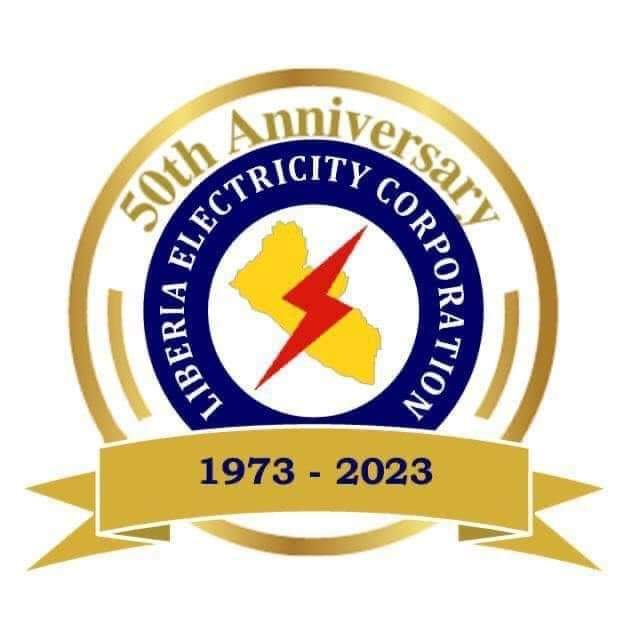𝑰𝒏𝒕𝒓𝒐𝒅𝒖𝒄𝒕𝒊𝒐𝒏
Liberia Electricity Corporation (LEC) is a publicly owned electricity utility company created by an Act of the National Legislature in 1973 (the LEC Act as amended by the LEC Amendment Act of 1976) with a mandate to generate, transmit and distribute electricity in Liberia.
During the Civil War, which started in December 1990, the electricity infrastructure was totally destroyed. Grid electricity was not restored until 2015, twenty-five (25) years later. The restoration of grid electricity was made possible through assistance from development partners, including the World Bank, African Development Bank, European Union, United States Government (USAID, MCC), Government of Germany (KfW), Government of Norway (NORAD), Government of Japan (JICA), and the European Investment Bank.
These donor projects focused on rebuilding the Mt. Coffee Hydro Dam, replacing HFO generators, reconstructing the transmission and distribution networks, connecting new customers, building capacity, and providing technical assistance. From November 2012 to December 2016, the management of LEC was contracted to Manitoba Hydro (MHI) of Canada through a Management Service Contract (MSC). At the expiry of the MSC at the end of 2016, an interim Liberian management team took over LEC for one year, from January to December 2017.
In January 2018, LEC was again placed under foreign management through an MSC with ESBI of Ireland. The ESBI MSC expired on July 22, 2022, and on July 23, 2022, the current Liberian management team headed by Monie R. Captan took over operational control of the company. In summary, since LEC was revived in 2012, it had been primarily under foreign management until July 23, 2022.
LEC’s Performance Under Management Contracts (2012-2022)
To fully grasp the magnitude of the progress achieved by the Liberian management team, a review of the company’s state at handover, along with baseline data of key performance indicators (KPIs), may be helpful. At the handover of LEC from ESBI to the present Liberian management team on July 23, 2022, the following conditions prevailed:
Debt accrued to ECOBANK was US$9m
Salaries and benefits to employees were delinquent and irregular. One out of four turbines at the Mt. Coffee Hydropower Plant was out of service due to a fire outbreak in the stator component. None of the four HFO plants at Bushrod Island was available for operation due to maintenance and repair issues
Highlights!
Accrued cross-border debt totaled $12.3 million, and (f) negotiations for a power purchase agreement for power import over the CLSG network were stalled.
With respect to utility performance indicators, the baseline data for select KPIs at ESBI’s departure (2021 annual report) were as follows: (g) Aggregate technical and commercial losses stood at 62.7%, (h) revenue stood at $30.33 million, (i) total customer population was 142,947, and (j) the entity’s balance sheet showed an aggregate financial loss of $20.9 million.
LEC’s Performance Under Liberian Management (2012-2022)
On assuming operational control of LEC, the Liberian management recorded the following achievements: (a) paid in full the $9 million debt owed to ECOBANK, (b) paid in full all outstanding salaries and benefits owed to employees, while regularizing the payment of salaries and benefits, (c) secured financing of $5.5 million through the World Bank LESSAP project for the repair of the damaged Mt. Coffee turbine for which procurement is ongoing, (d) repaired all HFO thermal generators leading to their full availability and current operation this dry season, (e) paid $3.7 million against cross-border debt thus reducing the debt from $12.3 million to $8.6 million; and (f) concluded negotiations for a Power Purchase Agreement with CI Energies/CIE and a Transmission Service Agreement with Transco CLSG in October 2022 (within 3 months).
Under the Liberian management, industry KPIs improved over the period as follows: (g) Aggregate technical and commercial losses dropped from 62.7% to 46.4%, with a reduction in commercial losses from 47.7% to 31.4% representing a 34% drop; (h) revenue increased from US$30.33 million to $54.67 million representing an 80% increase; (i) customer population increased from 142,947 to 282,505, representing an increase of 97.6%; and (j) Financial losses declined from -$20.9m to -12.9m, representing a reduction of 47.33% in annual financial losses.
MAJOR STRATEGIC INITIATIVES IMPLEMENTED BY THE LIBERIAN MANAGEMENT
Industry experts agree that LEC’s performance under the Liberian management, especially in commercial loss reduction, revenue performance, and customer connections, is unmatched in the African region. LEC achieved this performance through the following initiatives
1) Anti-Power Theft Task Force
In November 2022, LEC established an Anti-Power Theft Task Force in collaboration with the Liberia National Police under the joint chairpersonship of the CEO and Mary T. Broh. Operating from its base at Dupont Road, Paynesville, the Task Force has identified and corrected more than fifty thousand (50,000) unauthorized and illegal connections to the electric networks. LEC mobilized internal and donor resources to install over thirty thousand (30,000) meters to convert illegal connections (Direct Taps) to legal and paying customers. Furthermore, the data from the Task Force’s operations indicates that 99% of power theft instances are direct taps. The initiative is the predominant contributor to the results achieved in reducing commercial losses by almost 10%, from 41.3% to 31.4%.
2) Agile Metering & Fault Resolution Program
The new management understood that prompt attendance to customer needs improves customer satisfaction. The management immediately set out to revamp its customer service operations by increasing the number of call center agents, providing regular requisite training, and monitoring and evaluating agents’ performance. Besides concern for customer satisfaction, management also realized the significant role of customer responsiveness in the fight against commercial losses.
The Agile Metering & Fault Resolution initiative mobilizes technicians and engineers on motorcycles operating within defined zones to attend to customers’ needs. Using motorcycles and restricting the technicians’ mobility to the zone significantly decreases the time it takes to install a meter or resolve complaints.
3) Connection to CLSG
When the Liberian management took operational control, negotiations with Compagnie Ivoirienne d’Electricite (CIE) to import electricity from La Cote d’Ivoire had stalled. Meanwhile, electricity demand was increasing fast, with more large customers requesting connections to the grid. It was clear that without imports from the subregion, LEC would not meet peak demand even in the rainy season when Mt. Coffee could be relied upon to produce at maximum capacity. The new management, therefore, made the connection to the CLSG network one of its priorities and, within 3 months, concluded a power purchase agreement with CIE and a transmission service agreement with Transco-CLSG. As a result, energy consumed in the LEC network grew by 38% from 2022 to 2023, improving revenue performance.
4) Gap Community Electrification Project
LEC’s geographical scope covers four counties: Montserrado, Bomi, Cape Mount, and Margibi Counties. However, many communities within these counties, especially Montserrado County, are not yet connected to the grid. These communities are known as Gap Communities, which were not connected due to a lack of funding under donor projects. Some residents of these communities have, at times, resorted to protests, road closures, and even threats against LEC staff.
Additional counties, including Bong, Nimba, Grand Gedeh, River Gee, and Maryland counties, are serviced through franchisees.
The Rural Renewable Energy Agency is currently working on electrification projects for Sinoe, Grand Bassa, Lofa, and Grand Kru counties. However, the regional CLSG network has provisions for connecting all fifteen counties once the national transmission backbones and distribution networks are constructed.
In 2023, LEC established its Gap Communities’ Electrification Project (GCEP), which allocated funds from its operating budget to connect gap communities. So far, LEC has connected thirteen communities covering 6515 households for US$2,878,090.06.The GCEP is the first time since LEC was revitalized in 2012 that the Corporation is financing capital investment from its internal resources without donor support.
5) Customer Connections Under Donor-funded Electricity Access Expansion Projects.
In 2022 and 2023, LEC connected respectively 35,801 and 42,899 new electricity users under donor-funded projects. This significant connection was achieved through more focused and professional project management practices. In particular, these connections were managed to decouple the traditional link between customer numbers and losses. In the past, LEC recorded increasing commercial losses as more customers were connected to the network. This trend has been reversed since the new management has been in operational control
OUTLOOK 2024
LEC intends to build on the successes achieved in 2022 and 2023 to sustain reductions in commercial losses, revenue growth, and new customer connections. Management has set the ambitious target of 22.2% commercial losses, 377 GWh in sales, and a financial loss of only US$12.5 million. Management believes these targets are achievable.
These achievements were made over one and a half years, transforming LEC and placing it on a recovery trajectory. KPI targets for 2024 have been set as follows: 1) Commercial losses – reduce from 31.4 % to 22.2%; 2) revenue target increase from $54.62 million to $82.81 million. 3) increase customer connections from 282,505 to 366,669; and 4) reduce financial losses from$12.9m to $12.5 million.
LEC has signed a framework meter supply contract with two manufacturers for the delivery of 300,000 meters over three years. This will guarantee a constant supply of meters and reduce the time it takes to connect applicants to the network. This is important in the fight against commercial losses since available data shows that the vast majority of illegal connections to the network are direct taps. The corporations are also clarifying the framework for expanding and mainstreaming the Anti-Power Theft initiative to ensure that power theft has been reduced to zero. The meters from the framework agreement will be pivotal to attaining this ambitious goal.
Outstanding Challenges
LEC IS CONFRONTED WITH THREE MAJOR
CHALLENGES THAT MUST BE ADDRESSED:
To ensure commercial sustainability and the supply of adequate and reliable electricity, the three major challenges MUST be addressed.
The first, which most undermines the financial sustainability of the corporation, is power theft. Despite the unparalleled progress made over the last eighteen months, LEC’s commercial losses are still among the highest in the subregion. We know the extent and nature of the problem, and we know how to tackle it.
What we require, in addition to our initiatives and efforts, is the enforcement of the Anti-Power Theft Law. We also need the support of every citizen to protect the electric network from unauthorized tampering and illegal connections. Power theft affects us all because it undermines LEC’s capacity to buy fuel to generate sufficient electricity or pay for energy imported into the country.
Secondly, as the grid expands and demand grows, LEC’s network is reaching its optimum capacity, requiring upgrades in network capacity to improve network performance. This will require an upgrade of transmission lines and substations and the replacement of transformers. Such an upgrade is heavily capital-intensive and will require government investment in the electricity infrastructure. Many electrical grids within the subregion have gone through years without additional investment, contributing to inefficiency and underperformance.
The Government of Liberia, which is the sole shareholder of LEC, must make budget allocations to improve its electrical infrastructure. While development partners will help, this investment must be government-driven and government-owned. The Gap Community Electrification project is a bold initiative by LEC. However, 37 Gap Communities covering 33,768 households have not been connected to the grid. Connecting the remaining communities will cost approximately US$12.6 million. Despite its best intentions and efforts, LEC cannot raise sufficient resources to finance electrification projects.
It is better to reserve its operating capital, the hitherto source of funding the program, for the maintenance and operation of the national grid. Therefore, unless the Government or donors fund this initiative, many communities will remain deprived of access to electricity. LEC urges the Government to make budgetary allocations to connect these gap communities.
Lastly, the most pressing challenge is that demand has exceeded the electricity supply, especially in the dry season when hydro production is low and consumption increases.
Consequently, there is a supply gap requiring load shedding. Filling this gap requires significant capital investment and time. Increasing generation capacity takes money and time. Even when all the money for a power plant has been secured, it would take years to procure and build the facility. Beyond money and time constraints, LEC must select a source of generation that is affordable, renewable, and climate-sensitive.
Since the inception of the Ukraine War, fuel prices have increased dramatically, rendering the operation of fossil-based fuel generators unaffordable and a recipe for huge and uncontrollable financial losses. This peril is in addition to the impact of such power sources on carbon emissions and climate change. LEC has adopted a strategic generation plan to pursue a Hybrid Renewable Energy Integration solution, mainly pairing hydropower projects with solar power projects.
Under the World Bank RESPITE Project, LEC and the Government of Liberia have received financing totaling $96m for the expansion of Mt. Coffee by more than 50% of its current capacity and the construction of Liberia’s first-ever utility-size solar power plant. The solar power plant will be designed around a 20MWp capacity and located at Mt, Coffee. The procurement process for the solar plant is 50% completed, and the contract should be awarded by 2nd Quarter of 2024. Bid documents for the expansion of Mt. Coffee will be completed in 2024.
Additionally, a new hydropower plant is planned for upstream of the St. Paul River, known as SP2. The feasibility study should be completed by quarter 4 of 2024, and about 150 MW capacity is anticipated. SP2 will form a part of a planned cascade of hydropower dams along the St. Paul River, which will be serviced in the future by a storage reservoir at the confluence of the Via and St. Paul Rivers.
The project is estimated to cost around $550m and has already attracted interest from the World Bank and a commitment to fund approximately 50% of the project cost.
Conclusion:
With exponential demand growth, the electrical network is stressed, putting pressure on already constrained conditions. Customers demand more and better service quality. Yet the competing demands on LEC’s limited resources make it difficult to adequately address all issues concomitantly.
LEC must simultaneously address the issues of electricity supply gaps, quality of service, customer connections, labor union demands, logistics, and power theft.
LEC management understands and empathizes with the frustration of customers and is committed to continuously dedicating effort and resources to finding lasting solutions to the current energy crisis. In the meantime, and while major generation projects are underway, LEC will undertake the following measures to manage the current energy emergency:
1) maximize utilization of its HFO thermal plants, 2). continuation of load shedding, 3) negotiate an increase in energy imports over the CLSG to reduce the impact of load shedding, 4) encourage Independent Power Producers to invest in power generation projects, 5) undertake demand side management whereby large industrial users will confine usage of grid power to off-peak periods, and 6) continue to improve network efficiency.
While LEC’s management has recorded significant progress, sustaining this progress will require resources in the form of new investment, payment for electricity consumed by customers, including the government, and long-term planning and investment for energy transition and supply. LEC will also require a strong management culture based on merit and professionalism, free of undue political influence, and supported by good governance at the Board level.








